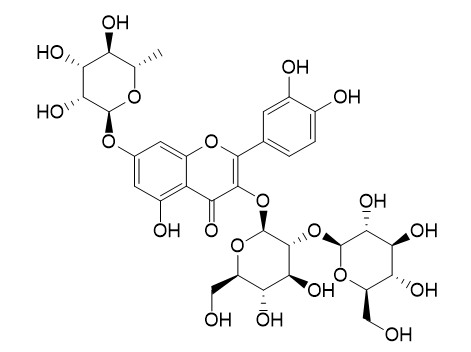Quercetin 3-O-sophoroside-7-O-rhamnoside
Reference standards.
Inquire / Order:
manager@chemfaces.com
Technical Inquiries:
service@chemfaces.com
Tel:
+86-27-84237783
Fax:
+86-27-84254680
Address:
1 Building, No. 83, CheCheng Rd., Wuhan Economic and Technological Development Zone, Wuhan, Hubei 430056, PRC
Providing storage is as stated on the product vial and the vial is kept tightly sealed, the product can be stored for up to
24 months(2-8C).
Wherever possible, you should prepare and use solutions on the same day. However, if you need to make up stock solutions in advance, we recommend that you store the solution as aliquots in tightly sealed vials at -20C. Generally, these will be useable for up to two weeks. Before use, and prior to opening the vial we recommend that you allow your product to equilibrate to room temperature for at least 1 hour.
Need more advice on solubility, usage and handling? Please email to: service@chemfaces.com
The packaging of the product may have turned upside down during transportation, resulting in the natural compounds adhering to the neck or cap of the vial. take the vial out of its packaging and gently shake to let the compounds fall to the bottom of the vial. for liquid products, centrifuge at 200-500 RPM to gather the liquid at the bottom of the vial. try to avoid loss or contamination during handling.
Naunyn Schmiedebergs Arch Pharmacol.2021, 394(1):107-115.
Enzyme Microb Technol.2019, 122:64-73
Molecules.2018, 23(12):E3103
Asian Journal of Chemistry2018, 30(12):2699-2703
Korean J. Food Preserv.2023, 30(4):663-668.
Biomolecules2021, 11(10),1513.
J Sep Sci.2021, 44(22):4064-4081.
Front Cell Dev Biol.2021, 9:764263.
Plants (Basel).2023, 12(5):1120.
Neurotoxicology.2022, 91:218-227.
Related and Featured Products
Antioxidants (Basel). 2019 Jul 31;8(8). pii: E260.
Phenol Profiling and Nutraceutical Potential of Lycium spp. Leaf Extracts Obtained with Ultrasound and Microwave Assisted Techniques.[Pubmed:
31370335 ]
In recent years, agricultural and industrial residues have attracted a lot of interest in the recovery of phytochemicals used in the food, pharmaceutical, and cosmetic industries.
METHODS AND RESULTS:
In this paper, a study on the recovery of phenol compounds from Lycium spp. leaves is presented. Ultrasound-assisted extraction (UAE) and microwave-assisted extraction (MAE) have been used with alcoholic and hydroalcoholic solvents. Methanolic UAE was the most successful technique for extracting phenols from Lycium leaves, and we used on leaves from L. barbarum and L. chinense cultivated in Italy. The extracts were then characterized as regards to the antioxidant properties by in vitro assays and the phenol profiling by a high performance liquid chromatography-diode array detector (HPLC-DAD). Chlorogenic acid and rutin were the main phenol compounds, but considerable differences have been observed between the samples of the two Lycium species. For example, cryptochlorogenic acid was found only in L. barbarum samples, while quercetin 3-O-rutinoside-7-O-glucoside and Quercetin 3-O-sophoroside-7-O-rhamnoside only in L. chinense leaves. Finally, multivariate statistical analysis techniques applied to the phenol content allowed us to differentiate samples from different Lycium spp.
CONCLUSIONS:
The results of this study confirm that the extraction is a crucial step in the analytical procedure and show that Lycium leaves represent an interesting source of antioxidant compounds, with potential use in the nutraceutical field.



